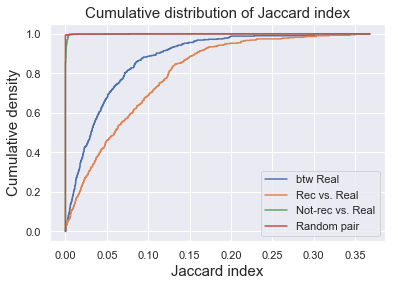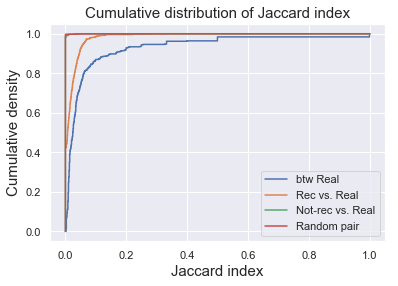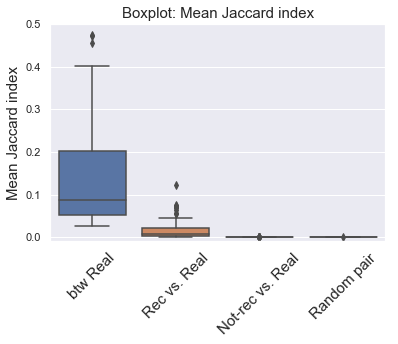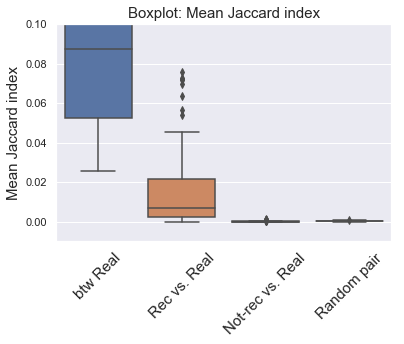Song Recommendation with NNCF
Contents
NNCF Recommendation on Non-random Dataset
Making Song Recommendation with Neural Collaborative Filtering
With the neural network collaborative filtering (NNCF), we are able to make song recommendation for existing playlists. Here we are using the NNCF model subset of 10,000 playlists genereated with a seed track (a popular song that belongs to >10,000 playlists) and demonstrate how we recommend new songs to those existing playlists.
The idea is to choose the songs that have the highest scores predicted by the network when paired with a specific playlist. We can then compute the Jaccard index of recommended songs and existing songs, and compare it to the Jaccard index between existing songs, and that between not-recommended songs and exisiting songs. A good recommendation would have a high Jaccard index (comparable to Jaccard index between existing songs).
First we load all the libraries.
import pandas as pd
import numpy as np
import matplotlib
import matplotlib.pyplot as plt
import seaborn as sns
import statsmodels.api as sm
import scipy.sparse as sps
import scipy
import pickle
import keras
from keras.models import load_model
import itertools
%matplotlib inline
sns.set()
Using TensorFlow backend.
Load data and model
Here we loaded the sparse matrix containing track-playlist contingency, as well as the best NNCF model.
# load files
sps_acc = scipy.sparse.load_npz('sparse_10000.npz')
# convert matrix to csc type
sps_acc = sps_acc.tocsc()
sps_acc
<74450x10000 sparse matrix of type '<class 'numpy.float64'>'
with 1030015 stored elements in Compressed Sparse Column format>
# load the best NNCF model
model_file = "models_10000/model.220-0.30-0.88.h5"
model = load_model(model_file)
# find track and playlist number
n_tracks, n_playlists = sps_acc.shape[0], sps_acc.shape[1]
Define functions
Then we define several functions.
- recommend_tracks This function makes recommendation of tracks that are not currently in a specific playlist. It returns the list of tracks that were predicted by the network as class 1 but have real label class 0, sorted by the score.
There functions were previously defined in Matrix Factorization section.
-
get_jaccard This function calculated the Jaccard index between a pair of tracks.
-
create_unique_pair_subset and create_pairs_btw_lists help creating pairs of tracks from given lists.
# this function returns the indices and scores for recommeded tracks given a playlist_id
def recommend_tracks(sps_acc, playlist_ind, model):
pairs = [np.ones((n_tracks,))*playlist_ind, np.arange(n_tracks)]
# make prediction with the model
prob = model.predict(pairs)
pred_class = prob.argmax(axis=-1)
# extract real class label from original data
real_class = np.array(sps_acc[:,playlist_ind].toarray()).reshape(-1,)
# real tracks: real class one
real_one_ind = np.argwhere(real_class).reshape(-1,)
# recommended tracks: predicted class one but real class zero
recom = np.logical_and(pred_class == 1, real_class == 0)
# find recommeded track index and score of being one
recom_ind = np.argwhere(recom).reshape(-1,)
recom_prob = prob[recom_ind,1]
# sort recommended indices from highest score to lowest
recom_sort_ind = np.argsort(recom_prob)
recom_ind = recom_ind[recom_sort_ind[::-1]]
# not-recommended tracks: predicted class zero and real class zero
not_recom = np.logical_and(pred_class == 0, real_class == 0)
# find not-recommeded track index and score of being zero
not_recom_ind = np.argwhere(not_recom).reshape(-1,)
not_recom_prob = prob[not_recom_ind,0]
# sort not-recommended indices from highest score to lowest
not_recom_sort_ind = np.argsort(not_recom_prob)
not_recom_ind = not_recom_ind[not_recom_sort_ind[::-1]]
return recom_ind, not_recom_ind, real_one_ind
Make recommendation for one playlist
Here we randomly selecte a playlist, and make recommendation of the top 10 songs with the highest scores predicted by the NNCF model. We then compute Jaccard index between the recommended songs and existing songs (rec vs. real), and compare that to Jaccard index between exisitng songs (btw real), and Jaccard index between exisitng songs and 10 randomly selected non-recommended songs (not-rec vs. real). Jaccard inex for Rrandom pairs of tracks was also computed as baseline.
# randomly select one playlist and make recommendation
playlist_id = np.random.choice(n_playlists, 1)[0]
# number of recommended tracks
num_rec = 10
# get recommendation from NN model
rec, not_rec, real = recommend_tracks(sps_acc, playlist_id, model)
# restrict number of real tracks to no more than 50
if real.shape[0] > 50:
real = real[np.random.choice(real.shape[0], 50, replace=False)]
# select rec and not_rec
rec = rec[:num_rec]
not_rec = not_rec[np.random.choice(not_rec.shape[0], num_rec, replace=False)]
# calculate the pair number
pair_num = real.shape[0]*num_rec
# collect jaccard index for rec-real pairs
rec_real_pairs = create_pairs_btw_lists(rec, real)
rec_real_jac = [get_jaccard(sps_acc,i) for i in rec_real_pairs]
# collect jaccard index for real-real pairs
real_real_pairs = create_unique_pair_subset(real, pair_num)
real_real_jac = [get_jaccard(sps_acc,i) for i in real_real_pairs]
# collect jaccard index for not_rec-real pairs
not_rec_real_pairs = create_pairs_btw_lists(not_rec, real)
not_rec_real_jac = [get_jaccard(sps_acc,i) for i in not_rec_real_pairs]
# random pairs
rand_pair_num = 100
rand_id = list(np.random.choice(n_tracks, 2*rand_pair_num))
rand_pairs = [(tr1,tr2) for tr1 in rand_id[:rand_pair_num]
for tr2 in rand_id[rand_pair_num+1:] if tr1<tr2]
rand_jac = [get_jaccard(sps_acc,i) for i in rand_pairs]
print('Mean Jaccard index\n rec vs. real =',np.mean(rec_real_jac),
'\n btw real =',np.mean(real_real_jac),
'\n not_rec vs. real',np.mean(not_rec_real_jac),
'\n random pair',np.mean(rand_jac))
Mean Jaccard index
rec vs. real = 0.0753801134917961
btw real = 0.046869115599796674
not_rec vs. real 0.0003663521751324832
random pair 0.0005184080936074024
Visualize result
We can visualize the distribution of Jaccard index of 4 groups by plotting their empirical cumulative density functions. As we can see here, the rec vs. real group and btw real have distributions of higher Jaccard index, meaning that the tracks are similar to each other (even more similar for rec vs. real than btw real), whereas the Jaccard index for not-rec vs. real group was really close to zero, comparable to random pairs of tracks. Therefore, the recommendation seems to be working well.
# visualize distribution of Jaccard index
ecdf1 = sm.distributions.ECDF(real_real_jac)
x1 = np.linspace(0, max(real_real_jac),1000)
y1 = ecdf1(x1)
plt.step(x1, y1,label='btw Real')
ecdf2 = sm.distributions.ECDF(rec_real_jac)
y2 = ecdf2(x1)
plt.step(x1, y2,label='Rec vs. Real')
ecdf3 = sm.distributions.ECDF(not_rec_real_jac)
x3 = np.linspace(0, max(real_real_jac),10000)
y3 = ecdf3(x3)
plt.step(np.concatenate((np.zeros(1,),x3)), np.concatenate((np.zeros(1,),y3)),label='Not-rec vs. Real')
ecdf4 = sm.distributions.ECDF(rand_jac)
y4 = ecdf4(x3)
plt.step(np.concatenate((np.zeros(1,),x3)), np.concatenate((np.zeros(1,),y4)),label='Random pair')
plt.legend(loc='best')
plt.title('Cumulative distribution of Jaccard index',fontsize = 15)
plt.xlabel('Jaccard index',fontsize = 15)
plt.ylabel('Cumulative density',fontsize = 15);

Scale up for 100 playlists
We can scale up our recommendation to 100 randomly selected playlists and look at the statistics of the Jaccard index of each group.
# randomly select 100 playlists
playlist_subset = np.random.choice(n_playlists, 100, replace = False)
# create empty lists
mean_rec_real_jac = []
mean_real_real_jac = []
mean_not_rec_real_jac = []
mean_rand_jac = []
# loop over playlist subset to get jaccard index
for ii, playlist_id in enumerate(playlist_subset):
# specify number of recommendation (=10 songs)
num_rec = 10
# get recommendation from NN model
rec, not_rec, real = recommend_tracks(sps_acc, playlist_id, model)
# restrict number of real tracks to no more than 50
if real.shape[0] > 50:
real = real[np.random.choice(real.shape[0], 50, replace=False)]
# select rec and not_rec
rec = rec[:num_rec]
not_rec = not_rec[np.random.choice(not_rec.shape[0], num_rec, replace=False)]
# calculate the pair number
pair_num = real.shape[0]*num_rec
# collect jaccard index for rec-real pairs
rec_real_pairs = create_pairs_btw_lists(rec, real)
rec_real_jac = [get_jaccard(sps_acc,i) for i in rec_real_pairs]
mean_rec_real_jac.append(np.mean(rec_real_jac))
# collect jaccard index for real-real pairs
real_real_pairs = create_unique_pair_subset(real, pair_num)
real_real_jac = [get_jaccard(sps_acc,i) for i in real_real_pairs]
mean_real_real_jac.append(np.mean(real_real_jac))
# collect jaccard index for not_rec-real pairs
not_rec_real_pairs = create_pairs_btw_lists(not_rec, real)
not_rec_real_jac = [get_jaccard(sps_acc,i) for i in not_rec_real_pairs]
mean_not_rec_real_jac.append(np.mean(not_rec_real_jac))
# random pairs
rand_pair_num = 100
rand_id = list(np.random.choice(n_tracks, 2*rand_pair_num))
rand_pairs = [(tr1,tr2) for tr1 in rand_id[:rand_pair_num]
for tr2 in rand_id[rand_pair_num+1:] if tr1<tr2]
rand_jac = [get_jaccard(sps_acc,i) for i in rand_pairs]
mean_rand_jac.append(np.mean(rand_jac))
Visualization
The boxplot below shows the distribution of mean Jaccard index of the 4 groups for the 100 playlists. Again, the rec vs. real group and btw real have very similar distribution, indicating high/comparable similarity between them. As expected, Jaccard index for not-rec vs. real group was close zero, showing low similarity (as random pairs of tracks).
# result visualization
# put results into dataframe
all_jac = np.concatenate((np.array(mean_real_real_jac),
np.array(mean_rec_real_jac),
np.array(mean_not_rec_real_jac),
np.array(mean_rand_jac)))
label = np.concatenate((np.ones(100,),np.ones(100,)*2,
np.ones(100,)*3,np.ones(100,)*4))
jac_df = pd.DataFrame({'jac':all_jac, 'label': label})
# plot boxplot
ax = sns.boxplot(x='label', y='jac', data=jac_df)
plt.xticks([0.,1.,2.,3.], ['btw Real','Rec vs. Real','Not-rec vs. Real','Random pair'],
fontsize = 15, rotation = 45)
plt.ylim([-0.01, 0.18])
plt.title('Boxplot: Mean Jaccard index',fontsize = 15)
plt.xlabel('')
plt.ylabel('Mean Jaccard index',fontsize = 15);

# put result into a dict and save it
jaccard_dict = {}
jaccard_dict['rec_real'] = mean_rec_real_jac
jaccard_dict['real_real'] = mean_real_real_jac
jaccard_dict['not_rec_real'] = mean_not_rec_real_jac
jaccard_dict['rand_pair'] = mean_rand_jac
with open('jaccard_100_playlists_NNCF10000_new.pkl','wb') as f0:
pickle.dump(jaccard_dict, f0)
with open('playlist_id_100_for_jaccard_NNCF10000_new.pkl','wb') as f1:
pickle.dump(playlist_subset, f1)
NNCF Recommendation on Random Dataset
Here we used the NNMF trained on the random 10,000 playlists dataset to make song recommendation.
Load data and model
Here we loaded the sparse matrix containing track-playlist contingency, as well as the NNCF model.
# load files
sps_acc = scipy.sparse.load_npz('sparse_10000_rand.npz')
# convert matrix to csc type
sps_acc = sps_acc.tocsc()
sps_acc
<171381x10000 sparse matrix of type '<class 'numpy.float64'>'
with 657056 stored elements in Compressed Sparse Column format>
Make recommendation for one playlist
Here we randomly selecte a playlist, and make recommendation of the top 10 songs with the highest scores predicted by the NNCF model. We then compute Jaccard index between the recommended songs and existing songs (rec vs. real), and compare that to Jaccard index between exisitng songs (btw real), and Jaccard index between exisitng songs and 10 randomly selected non-recommended songs (not-rec vs. real). Jaccard inex for Rrandom pairs of tracks was also computed as baseline.
Mean Jaccard index
rec vs. real = 0.016874325885359583
btw real = 0.06867752650047514
not_rec vs. real 0.00015570566551471537
random pair 0.00031485758244769997
Visualize result
We can visualize the distribution of Jaccard index of 4 groups by plotting their empirical cumulative density functions. As we can see here, the rec vs. real group and btw real have distributions of higher Jaccard index, meaning that the tracks are similar to each other (even more similar for rec vs. real than btw real), whereas the Jaccard index for not-rec vs. real group was really close to zero, comparable to random pairs of tracks. Therefore, the recommendation seems to be working well.

Scale up for 100 playlists
We can scale up our recommendation to 100 randomly selected playlists and look at the statistics of the Jaccard index of each group.
Visualization
The boxplot below shows the distribution of mean Jaccard index of the 4 groups for the 100 playlists. The btw real had the highest Jaccard index, indicating high similarity between each pair. The rec vs. real had low but above zero Jaccard index. Jaccard index for not-rec vs. real group was close zero, showing low similarity (as random pairs of tracks).

Zoomed in:
